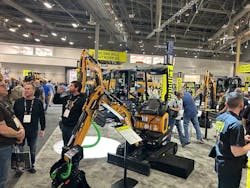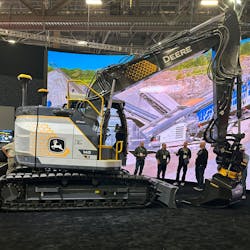5 Factors Driving Uptake of Electric Construction Equipment
The electrification of construction equipment and other heavy-duty machinery continues to grow as technology improves and interest in use of such machines increases. Construction equipment is a key sector for the fluid power industry, especially the hydraulics segment. As such, the push toward electrification is bringing new design considerations for hydraulics and pneumatics systems.
But what is driving the development of electric-powered construction equipment? During CONEXPO-CON/AGG in March 2023, David Knight, CEO of Terbine — a provider of technology for the exchange of IoT (Internet of Things) data between the mobility and energy sectors — spoke on the subject, saying there are five main reasons construction equipment end users are considering use of electric-powered machines.
Knight predicts that in about 3 years, the growth of electrification will lead to approximately 700 electric vehicles on the road. Add construction equipment and other heavy machinery into the mix and the number of electrified vehicles in the market will be even higher.
Key Drivers for Uptake of Electric Construction Equipment
Although government regulations have been a noted driver of the move toward further electrification in several industries, and remains a key element, there are several other factors leading the transition. During his presentation at CONEXPO 2023, Knight outlined the top five reasons those in the construction industry are considering, or have already invested in, electric-powered construction equipment.
Lower Operating Costs
Fuel tends to be one of the largest operating expenses for construction equipment owners and the cost of diesel has gotten increasingly higher in recent years. Powering machines with electricity, however, offers a lower cost option as many machines can be recharged using energy already provided by the grid.
There are of course challenges associated with charging infrastructure and whether the current grid will have the capacity to meet charging needs as electrification expands, but in general the cost of powering electric machines is lower compared to diesel.
Knight also pointed to the fact most electric construction equipment averages about 4-8 hours of operating time, depending on the duty cycle. The power and performance of electric machines is typically equivalent, if not better in some instances, to diesel alternatives which benefits end users' productivity and overall operations.
He noted that while electric machines usually require about an 8-hour overnight charge, there is no idling common with diesel-powered equipment which enables more productive work to be gotten out of a machine.
Advancements in the components and systems within electric construction equipment, such as the hydraulics systems, can benefit operating costs as well. A key area of design focus is making hydraulics more efficient, leading to longer run times as less energy is required from the battery to operate these systems.
Reduced Maintenance
Electrification of construction equipment can help to reduce the amount of maintenance required. This is because electric machines are comprised of more electronic components which have fewer moving parts and thus less opportunity for wear.
The reduced chance for wear helps to minimize unplanned downtime and its associated costs, as well as the costs necessary for maintenance, helping further lower overall operating costs for machine owners.
Efficiency improvements and other design aspects of fluid power components used in electric construction equipment can help to minimize maintenance as well. There are also a few examples of electric machines in which the hydraulics system has been completely replaced by an electric alternative — consisting of electric actuators, control hardware and more — which can further reduce maintenance needs by eliminating the chance for hydraulic fluid leaks or other issues that could arise.
READ MORE: Moog and Komatsu Develop All-Electric Wheel Loader
Federal and State Tax Credits
To help those interested in purchasing electric construction equipment, there are several state and federal government organizations offering tax credits. By doing so, these organizations are helping to lower the barrier of entry for the purchase of electric machines which will help to increase their uptake.
According to Knight, these tax credits can provide savings in the tens of thousands or hundreds of thousands for a single fleet which could greatly ease the initial purchase price of electric machines. Electrified construction equipment does tend to have a higher upfront cost, but their lower lifetime costs is seen as a counterpoint to this.
Carbon Credits and Offsets
Use of electric-powered construction equipment can help construction and other companies with carbon credits and offsets as well. Carbon credits, also known as carbon allowances, can be purchased by a company which allows it to generate 1 ton of carbon dioxide (CO2) emissions.
Companies which remove a unit of carbon from the atmosphere as part of their normal business activity generate carbon offsets, explained Knight. These can be purchased by other companies for their own carbon footprint reduction efforts.
ESG Goals
Sustainability has become a stronger focus for many companies, including those in the construction industry. As part of this, several have set Environmental, Social and Corporate Governance (ESG) goals in an effort to hold themselves accountable for achieving sustainability and other targets.
In relation to this, many companies have set timelines in the coming years for reducing their carbon emissions by a certain percentage. A number of companies are doing so in line with the Science Based Targets Initiative to help them create a clear path for achieving these emissions reduction goals. Many companies see this as not only an imperative for helping the climate but also an opportunity for their business to be on the cutting-edge of technology and business developments.
READ MORE: Volvo Sees Continued Growth Opportunity in Electrification
Cities around the world aim to reduce the amount of emissions by enacting emissions limits and in some cases even total bans of emissions-producing vehicles within certain areas. This will drive the need for electric construction equipment, which is zero emissions, so it can work in these emissions zones. Some projects on which construction equipment is used have started to require use of more environmentally friendly equipment and practices as well, further driving the need for electrified machinery.
Technology will Benefit Market Uptake
As the technology behind electric construction equipment continues to advance, so will its uptake. These advancements will bring longer run times, improved efficiency and an expansion of the types of machines which are electrified, among other benefits.
Knight believes this will help lead to an even greater level of adoption in the near future.
Among the advancements he sees taking place is the use of higher voltages for electric vehicle architectures. According to Knight, the higher the voltage the less current required for a given amount of wattage. This also reduces the amount of heat generated by electric vehicle systems.
Higher voltages will also be required as larger machines become electrified, or at least hybridized in the nearer term. Delta-Q Technologies, a developer of on-board battery chargers, has noted this shift toward larger electric-powered off-highway equipment. Because of this, the company introduced its latest battery charger, the XV3300, at CONEXPO 2023. The company told Power & Motion during an interview at the show that the 3.3 kW charger was developed to meet the increasing power and faster charging requirements of larger electric-powered equipment.
READ MORE: Construction Equipment Digs Deeper into Electrification
Knight concluded his CONEXPO presentation by saying the efforts to advance electric construction equipment and user of higher voltages will make the machines "really good in 3-5 years, and that's going to allow for even faster and more efficient charging than ever before."
*Editor's Note: This article is based on information supplied by the Association of Equipment Manufacturers (AEM).
Learn more about technologies and trends related to electrification of construction equipment.
The Impacts of Electrification on Fluid Power Systems
How to Safely Work with High-Voltage Systems
3 Drivers of Off-Highway Electrification
About the Author
Sara Jensen
Executive Editor, Power & Motion
Sara Jensen is executive editor of Power & Motion, directing expanded coverage into the modern fluid power space, as well as mechatronic and smart technologies. She has over 15 years of publishing experience. Prior to Power & Motion she spent 11 years with a trade publication for engineers of heavy-duty equipment, the last 3 of which were as the editor and brand lead. Over the course of her time in the B2B industry, Sara has gained an extensive knowledge of various heavy-duty equipment industries — including construction, agriculture, mining and on-road trucks —along with the systems and market trends which impact them such as fluid power and electronic motion control technologies.
You can follow Sara and Power & Motion via the following social media handles:
X (formerly Twitter): @TechnlgyEditor and @PowerMotionTech
LinkedIn: @SaraJensen and @Power&Motion
Facebook: @PowerMotionTech

Leaders relevant to this article:




